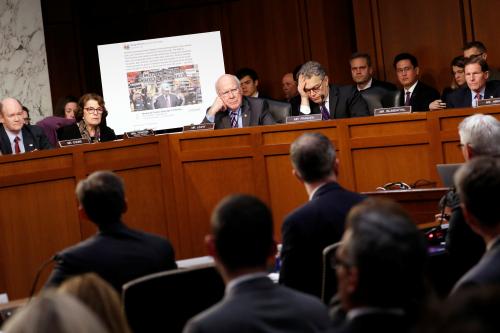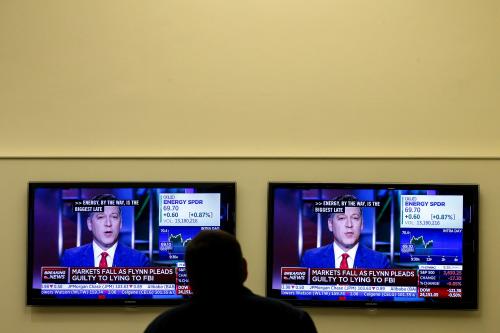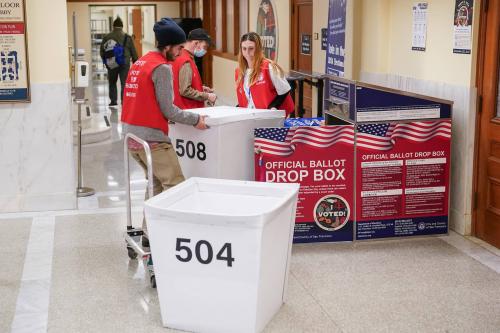Twitter finally started fact checking Trump’s tweets in May, but their fact-checking is unlikely to have much effect given the president’s parallel attacks against the media and platforms. Such attacks reduce trust among the very audience following his disinformation, and credibility of the source with the audience is vital to their believing the fact checking.
Two years after the Cambridge Analytica scandal, propaganda, data misuse, disinformation, and strategic influence present some of the most complex and rapidly evolving challenges for researchers, civil society, and policymakers in our time. But how well are we tackling this problem, and what’s left to do? Efforts at the policy level to regulate, legislate data privacy, and pressure platforms to remove noncompliant content are making baby steps forward but still have a long way to go.
The public response to Cambridge Analytica and disinformation online has been almost entirely reactive. Most noticeably, we have seen researchers and journalists focus on identifying examples of disinformation and notifying platforms. Tens of millions of dollars are spent by platforms on disinformation research tracking online campaign messaging dissemination and consumption on social media. While these efforts can be valuable, a focus solely on tracking content will tend toward solutions such as content removal. This approach ignores the issue of what motivates platforms to act and may miss other ideas and responsible parties.
The tracking approach often observes content without deriving and recommending solutions. It tackles only the visible surface the problem and is unable to identify the creators of content, the corporations, governments, or other organizations funding it, or their use and misuse of data. To fully understand the issues raised by digital influence campaigns, or develop new ways to respond to them, it is necessary to also focus on exposing and responding to the rapidly expanding digital influence industry.
Influence campaigns in U.S. elections
Politicians within the United States meanwhile have escalated an arms race where influence firms operating in the shadows are the biggest winners. Trump campaign manager Brad Parscale and former Cambridge Analytica employees working for Trump promise the biggest data operation yet driving Trump’s message. Geofencing has been reported as a new tactic in use in the 2020 Trump campaign. However, it isn’t that new a method; in a letter I obtained for my upcoming book ‘Propaganda Machine: Inside Cambridge Analytica and the Digital Influence Industry’ indicate that Cambridge Analytica had tools for gathering data using geofencing from individuals at shooting ranges and sporting goods stores to get ‘strong universes of individuals that we know are prone to be aligned to your cause’.[1]
Similar tools were then reported to have been deployed by Steve Bannon to target churches in the midterms as revealed in a scene deleted from the documentary “The Brink”. The pandemic has had consequences for the mass-rallies Trump ran on in 2016 and could affect his ability to mobilize voters. Harvesting data on religious affiliation has become increasingly central to Donald Trump’s current re-election campaign. In March 2020 Trump was urging churches to reopen ‘right now’ mid-pandemic—We should all be extremely concerned at the potential for how data-harvesting could be abused with real-world repercussions.
Meanwhile, Democrats have funded massive, and often ineffectual, data-driven campaigns—plowing more money into the digital influence industry’s pockets rather than mobilize people behind democratic reforms. Efforts like ‘Defeat Disinfo’, a newly established political action committee, claim to counter disinformation using military-derived AI but really put out counter-Trump messaging. Portraying political opposition as responding to disinformation risks undermining the credibility of efforts that fight hard to be perceived as politically neutral. It makes it look like the problem is being addressed at a time when real fact-checkers like Snopes are struggling to cope with the scale of pandemic-related misinformation; and it risks confusing or misleading audiences seeking factual information they can trust.
We need more holistic research and policy approaches aimed at addressing the influence economy and the unethical industry practices. I gave testimony to the UK parliament and the U.S. Congress on this issue in 2018, and despite recommendations made on how to tackle this, and much tracking of online content, the multi-billion dollar global influence industry of which Cambridge Analytica was a part remains largely opaque and unregulated. The Cambridge Analytica reporting focused mostly on platforms like Facebook without advancing a necessary conversation about the influence industry too.
Influence campaigns abroad
As statues of racist leaders are toppled it’s important to also topple racist systems that transfer power to oligarchs and elites. The Cambridge Analytica story is a story of how the new digital mercenaries transformed the influence industry to extend contemporary imperialism. The worst abuses by Cambridge Analytica and its parent company SCL occurred beyond the economically powerful West. With white consultants setting up in places such as the Caribbean, Africa or South America—places without strong civil society or privacy protections—and being paid millions to undermine local peoples’ hopes of a better future for their country. These concerns led me to create the just-launched Cambridge Analytica Interactive Map of the world, a transparency tool mapping their work and visualizing their global reach; you can explore countries, years, hit ‘play’ and watch them spread around the globe—both in democracies and where civil society is most vulnerable.
Even after scandals and bankruptcies, the legacy of the company lives on through new entities and a sprawling industry. Influence firms such as these can utilize global offices and partners in different jurisdictions strategically to obscure their operations. It is necessary to widen our lens beyond the Western gaze to reveal and respond to who is driving the latest flurry of false posts. SCL and Cambridge Analytica were only one medium-sized firm. As the platforms begin to respond, it is now time to turn our attention to the forgotten ‘influence industry’ and its commercial, government and political clients worldwide.
Illuminating the influence industry involves not just mapping tweets or Facebook posts, but revealing the powerful networks of companies and clients that stretch around the world, patterns of data use and technologies, funding streams, clients, and strategies—and communicating complex data for policymakers and publics in accessible ways that reveal how we respond. People have the power to adapt more quickly than policy and may well influence it, but their ability to be effective as they anticipate, organize and disrupt different tactics will depend on equipping them with richer information and more useful tools. Let’s topple more than just statues.
[1] Internal Cambridge Analytica memo from November 2015, provided by Former Employee, 2019.
Facebook is a general, unrestricted donors to the Brookings Institution. The findings, interpretations, and conclusions posted in this piece are solely those of the author and not influenced by any donation. The author has not received any donations from Facebook.





Commentary
We need tougher action against disinformation and propaganda
July 15, 2020